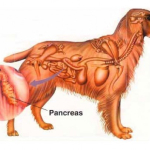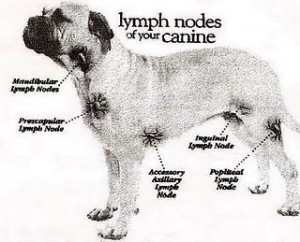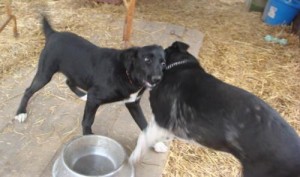Articles in the Dog Health Category
Dog Health »
Dog anal glands health
Examining your dogs anal glands while grooming and regular is imperative to make sure the glands are in ideal health. It is possibly one of the least pleasant undertakings for dog owners, although for years many people that had dogs did not know that canine anal glands existed.
How a Dogs Anal Gland is Emptied
Canines will empty these glands while eliminating. As the stool passes out of the anus, the pressure will usually clear the anal sacs; however, because of the domestication of dogs, some of our canine friends have a problem clearing their sacs. Impacted anal glands are most common in small dogs and are indicated by your pet scooting on the ground or licking and biting at his rear and you will most likely notice a dog odor.
Why Expressing Dogs Anal Glands is Important
When emptying of the sacs does not occur, they can become impacted and it is very distressing and painful for your dog. They must be expressed or infection and abscess can follow if the impact isnt alleviated. The usual size of the sacs is that of a kidney bean but when they are impacted the glands will become larger and feel hard. Generally, the clogged glands will be extremely sensitive and your pet may react as if in pain when you touch near that area.
Where to Find a Dogs Anal Glands
Anal sacs can be found on either side of the lower half and just within your pets anus. They are lined with cells that regularly exude a very pungent discharge. If you look closely, you will probably see the teeny ducts through which a foul smelling fluid seeps. In the wild the secretions are used to mark territory, but in the domestic canine they have little use apart from the attention they receive from other canines, who (for reasons humans find difficult to comprehend) find it appealing. There is no obvious scent to humans when your pet is bathed routinely and your dogs anal glands are in good shape. Other dogs on the other hand have no problem the odor.
Expelling the Sacs
To avoid the expense of having the sacs expelled, you can do this yourself; however, some dog owners feel it is well worth having a veterinarian carry out this service, at least the first time . To express the glands, wear a throw away latex glove. Holding a tissue, place your thumb and forefinger on both sides of the anus and squeeze gently. Anal sack fluid should exude from the ducts without much pressure and you will likely feel the glands decrease in size as you gently squeeze. If you are hesitant about doing this or notice anything curious, consult your veterinarian. It is best to have someone hold your pet still, while you do this.
A Change of Diet
Your veterinarian may suggest a diet high in fiber if you find your pet is having consistent difficulty with blocked anal sacs. The added fiber will help to express the anal glands when your buddy defecates.
If Infection Occurs
If anal glands become infected they will enlarge and may erupt through the skin by the anus. This will produce a painful draining abscess and will need appropriate veterinarian care and in all probability manual expressing of the glands until the abscess has gone.
Re-occurring Impacted Glands
If the impacted anal glands become a persistent issue for your buddy, they can be surgically removed. This can often result in a more pleasurable relationship for you and your dog.
This is considered routine surgery but there are potential problems because of the numerous nerves in that area and fecal incontinence may develop if too much damage happens. Additionally, if your dogs anal glands tissue was not completely removed, they have the possibility to continue secreting fluid. When this builds up, the result could be an abscess and perhaps a continual draining tract from the sac to the skin. If this occurs the veterinarian will have to go back and remove the sac tissue to have a successful result.
Dog Health »
Mammal Chiropractor
D.D. Palmer of United States of America developed Chiropractic in the year 1895. At present it is practiced in about 100 years. On the other hand the medical fraternities do not admit this practice as scientific. Get a Chiropractor in Plano to help you get rid of your pain.
The chiropractic attitude is based on the fact that living organism contains a number of elements which cannot be explained by the material concept. They philosophically assert that living beings are made up of matters which have a material form and are also made up of subtle elements which cannot be realized materially.
This philosophy separates chiropractic from other forms of medicine like allopathic. Naturalism, rationalism and holism are some of the philosophical elements which constitute chiropractic. A Chiropractor in Plano can help you find natural remedies.
Animal chiropractor have knowledge and education about the chiropractic science
Animal chiropractor focuses mostly on the relationship which exists between the spinal column and the nervous system. How one affects the other and what are the corrective measures which one can adopt in order to treat the animals are some of the areas on which an animal chiropractor focuses. The animal chiropractor also studies the musculo-skeletal system deeply this helps them to diagnose the cause of the problem in a more efficient manner.
It is frequently suggested that a vet should be referred before taking the help of an animal chiropractor. The vet will determine the primary cause of the problem and may advocate for a chiropractor. In minor cases the problem may fix up on its own but if the problem persists then immediate attention is required or else the state might degenerate.
The chiropractor will attempt to learn the body muscles and the tissues; a comprehensive study of the gait and the posture will be carried out in order to understand the problem. The movement of the animal spine will be carried out, whether any muscle spasm is present or not will be checked out or if there is any hot spots or cold spots present will be thoroughly examined by the chiropractor. Any bizarre movement that to for a long period will indicate that, the problem is serious.
Following correctly diagnosing the problem the chiropractor will, resort to treatment. The treatment is aimed to bring the animals body to the normal level. The treatment provides immense relaxation to the animal and most of the time it has been observed that the animals enjoy the treatment. Once the animals body reaches to its regular level and the balance in the body is established the animal can get back to its ordinary routine.
Aftercare is very much vital here in fact if the after care is not proper then the animal may not recover completely and after sometime the pain may become intense. After the treatment the animal may take some time to recover completely; it all depends on the intensity of the problem. A chiropractor should treat the animal under the supervision of a veterinary surgeon and after the treatment he should send a thorough report to the vet.
An animal chiropractor must have proper knowledge and education about the chiropractic science. Apart from the theoretical knowledge he should also have practical knowledge. Dr. Lee Lallier is the Chiropractor in Plano. Give him a call at (972) 285-7000 today to schedule an appointment.
Dog Health »

Pancreatitis disease targets older female dogs. Your dog develops pancreatitis when digestive enzymes destroy tissue in the pancreas. This is a potentially fatal disease that generally targets older, female dogs. Breeds such as miniature poodle, miniature schnauzer, and cocker spaniel also have an increased risk. Here is everything you need to know about pancreatitis in canines.
Dog Health »
Melanoma can affect your dogs mouth, skin, or toes. This very serious cancer can also occur behind the eye. This article will discuss a href=http://www.dog-illnesses.com/canine-melanoma/ target=_blankcanine melanoma/a.br /
br /
Symptomsbr /
br /
Its common for dogs with this condition to develop oddly shaped or colored skin lesions. If the mouth is affected, your dog may develop bad breath, drooling, coughing, and trouble swallowing. This leads to loss of appetite and weight loss. Tumors can also develop on the toes.br /
br /
Diagnosisbr /
br /
The first step in diagnosing canine melanoma is a physical exam. In order to get a complete blood count, a blood sample will need to be drawn. The condition of the lungs may also need to be checked. This can be done with an x-ray. A biopsy of the tumor may also be taken.br /
br /
Treatmentbr /
br /
Melanoma in dogs can be treated in various ways. The disease will spread quickly without treatment. Surgery involves removal of the tumor. Only a portion of the tumor will be removed if the whole tumor cant be removed. Radiation and chemotherapy can be used to try to reduce the size of the tumor.br /
br /
Prognosisbr /
br /
Melanoma is a very serious type of cancer in dogs. The prognosis is usually poor. The best chance of survival is presented when only the skin is affected. Sometimes the cancer will still spread despite treatment. Also, a successful treatment doesnt guarantee that the cancer wont recur.br /
br /
Your precious pet can be susceptible to a href=http://www.dog-illnesses.com/ target=_blankcanine illnesses/a. You can read up on many different potential health problems at dog-illnesses.com. So, come by right now to become informed.br /
br /
Access important ideas to a href=http://www.freedogstips.com/free-dogs-tips-videos/train-dog-to-stay-off-beds-how-to-house-train-dogs.html target=_blankhouse training dogs/a – this is your personal knowledge pack.
Dog Health »
Lymphoma in dogs cancer can affect dogs body
Lymphoma in dogs is a condition that occurs when cancer cells affect lymph tissue. Virtually every organs grows lymphoid tissue. Therefore, this cancer can affect any area of your dogs body. This type of cancer is more common in middle-aged dogs. Keep reading to learn more about a dog lymphoma.
Lymphoma Signs
The most prominent sign of dog lymphoma is swelling of the lymph nodes. As mentioned, this disease can affect any organ in the body. Dogs with lymphoma exhibit symptoms based on the particular area that’s affected by the cancer cells.
For example, two common areas that are affected by this disease include the gastrointestinal tract and chest. If the gastrointestinal tract is affected, your dog may experience diarrhea, vomiting, weight loss, and loss of appetite. Dogs with cancer affecting the chest will likely develop shortness of breath.
[caption id="attachment_1535" align="aligncenter" width="300" caption="Dog Lymphoma"] [/caption]
[/caption]
Lymphoma Diagnosis
Lymphoma may be suspected if the lymph nodes are swollen. A physical exam is followed by urine and blood tests. One of the swollen lymph nodes can be biopsied in order to provide a definitive diagnosis. A biopsy will also help determine how severe the cancer is.
Lymphoma Treatment
Lymphoma in dogs is usually treated via chemotherapy. Chemotherapy successfully leads to remission in most dogs. Chemotherapy can be given orally or by injection. Chemotherapy is much less successful if the condition has already progressed.
Lymphoma Prognosis
As stated earlier, treatment can bring about a remission. However, the disease will likely recur sometime in the future. Once the cancer returns, your dog needs chemotherapy again. However, any subsequent remission will last half as long as the preceding one. Chemotherapy to treat lymphoma in dogs can be quite costly. The disease is usually fatal within a couple years of diagnosis.
All dog owners should know a little something about various diseases that can affect their dog like canine hot spots. You can read up on many different potential health problems at dog-illnesses.com.
Photo source:geetasharmavet.blogspot.com
Dog Health »
The kidneys are responsible for many tasks. They include balancing chemicals and eliminating toxic wastes. Kidney disease in dogs occurs when the organs are no longer able to function properly. Keep reading to learn all about a href=http://www.dog-illnesses.com/canine-kidney-disease/ target=_blankcanine kidney disease/a.br /
br /
Formsbr /
br /
This condition can either be acute or chronic. Acute kidney disease can cause permanent damage and occurs suddenly. This health problem can affect dogs of any age. Dogs with the chronic form of this disease develop it slowly over time. This form is generally a problem for older dogs.br /
br /
Causesbr /
br /
Your dog can develop kidney disease for many reasons. Ingestion of toxic substances such as antifreeze or rat poison is a common reason. Dogs with fungal infections, bacterial infections, or heart disease can also have problems with their kidneys. Kidney function will naturally decline with age, so aging also plays a role.br /
br /
Symptomsbr /
br /
Kidney disease in dogs causes various signs. Two of the most common include increased urination and drinking. Dehydration can also become a problem. Loss of appetite, muscle weakness, and discolored teeth are also common. Another common sign of kidney disease is a href=http://www.dog-illnesses.com/canine-diarrhea/ target=_blankdiarrhea in dogs/a.br /
br /
Diagnosisbr /
br /
If your dog displays some of the aforementioned symptoms, you should have him checked out as soon as possible. Your dog will have to submit a blood and urine sample to be analyzed. An x-ray and ultrasound may also be useful. A kidney biopsy is the most definitive method of diagnosis.br /
br /
Treatmentbr /
br /
In order to treat kidney disease in dogs, the underlying cause must be treated first. Toxic wastes can be removed from the blood using intravenous fluids. Your dog will need to have dialysis if the intravenous fluids dont do the job.br /
br /
Chronic kidney disease cant be treated. Treatment is designed to help slow down the diseases advancement. Your dog will have to eat a special diet and drink plenty of water.br /
br /
Your precious pet can be susceptible to many different health conditions. You can read up on many different potential health problems at dog-illnesses.com. So, come by right now to become informed.br /
br /
Access useful points of view to a href=http://www.freedogstips.com/free-dogs-tips-videos/train-dog-to-stay-off-beds-how-to-house-train-dogs.html target=_blankhouse training dogs/a – welcome to your personal knowledge pack.
Dog Health »

Seizures in dogs sign of neurological problems. If your dog experiences seizures, its a sign that he’s suffering from some type of neurological problems. There are various things that can cause a dog to have a seizure besides epilepsy. Some of these include diseases like distemper, tumors, and toxins. Here’s a look at various causes of seizures in dogs.
Dog Health »
The liver is an extremely important organ. In some way, the liver is involved in almost every biochemical process. Therefore, liver disease in dogs is a serious medical condition. Here is a brief introduction to a href=http://www.dog-illnesses.com/canine-liver-disease/ target=_blankliver disease in canines/a.br /
br /
Causesbr /
br /
There are many different causes of liver disease in canines. A severe blow to the front of the abdomen can cause trauma to the liver. Getting hit by a car is a common example. Viral, fungal, or bacterial infections can also cause liver disease. Heartworms can also lead to disease if they grow severe enough to block the flow of blood to the liver. Dogs suffering from liver disease display a range of symptoms.br /
br /
Symptomsbr /
br /
As you have already learned, virtually every biochemical process involves the liver. Liver disease can lead to problems with others areas of your dogs body. This is why liver disease in canines causes such unspecific symptoms. Able to function with up to 80 percent damage, the liver is a very durable organ. Unfortunately, this means signs dont appear until the disease has already advanced.br /
br /
Dogs with liver disease suffer abdominal pain recurrently. Its also common for dogs to experience vomiting, loss of appetite, and diarrhea. Its also common for there to be a href=http://www.dog-illnesses.com/canine-constipation/ target=_blankdog constipation/a. Since the liver will stop processing bile properly, your dogs feces will be gray instead of brown. Other dogs also suffer from weight loss, increased drinking and urination, and jaundice.br /
br /
Diagnosisbr /
br /
Diagnosis of canine liver disease involves a urinalysis, complete blood count, and chemistry screen. The veterinarian will also take an x-ray of your dogs abdomen. This will show any change in liver size, as well as abnormalities in circulation and mineralization. In some cases, the vet may elect to perform an ultrasound. The most definitive method of diagnosis is to take a biopsy of the liver. A biopsy involves removing a piece of the liver using a special needle or via surgery. The liver is capable of regeneration, so any removed piece wont cause any problems.br /
br /
Treatmentbr /
br /
The specific treatment for your dog depends on damage severity and underlying cause. Toxic substances that can cause damage to the organ have to be removed. Your dog may also need to be placed on a special diet. This will help decrease the livers workload, so it can hopefully recover. Dogs are also susceptible to secondary infections, so they will need to be treated with antibiotics.br /
br /
Your precious pet can be susceptible to many different health conditions. Fortunately for you, you can learn about a wide range of these conditions at dog-illnesses.com. Click over right now.br /
br /
Read competent points of view to a href=http://www.freedogstips.com/free-dogs-tips-videos/train-dog-to-stay-off-beds-how-to-house-train-dogs.html target=_blankhouse training dogs/a – your individual guide.
Dog Health »
Ringworm skin disease in dogs
Ringworm in dogs is a highly contagious skin disease. A worm doesn’t cause this condition, although its name may suggest so. Instead, this disease is caused by fungus that lives in hair follicles.
Ringworm Cause
Dog ringworm can be caused by various species of fungus. This highly contagious fungi can be transmitted to other pets in your household. Your dog can also transmit the disease to you. You can also pass it on to your dog if you have the condition.
Ringworm Signs
Dogs don’t display any visible signs until two weeks after being exposed to the fungus. Hair begins to fall out in a round pattern as the hair shafts become weakened. Its also common for dogs to develop crusty or scaly skin.
Ringworm Diagnosis
[caption id="attachment_1778" align="alignright" width="300" caption="Ringworm in Dogs"] [/caption]
[/caption]
Your vet will easily be able to tell if your dog has ringworm using a Woods lamp. Some species of fungus glow when exposed to this ultraviolet lamp. A hair sample can also be taken and monitored for fungal growth. However, fungus grows slowly, so this method of diagnosis can take weeks.
Ringworm Treatment
Ringworm in dogs can be treated various ways. One method involves using a special antifungal shampoo. This process will have to be repeated multiple times. If these are skin lesions, they can be treated using antifungal cream. This process usually lasts for about ten days.
A last treatment option for dog ringworm is oral medication. This form of treatment can last up to a month. The environment also needs to be treated to prevent reinfection. Its best for you not to use his collar, bedding, or grooming utensils again.
Photo source:caspca.blogspot.com
Dog Health »

Yeast in dog’s ears seems to be a big issue for many dog owners. Leaving the owner surfing the net for a remedy that will actually work for a dog ear yeast infection. Over the years we have had to deal with yeast infections in dog ear’s and have found a few at home remedies to treat the yeast issues.
Yeast thrives in warm and moist environments, making a dogs ear the perfect place to grow! Here is a great remedy to help get rid of dog ear yeast!
















 The
The